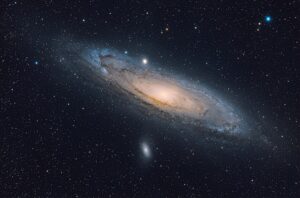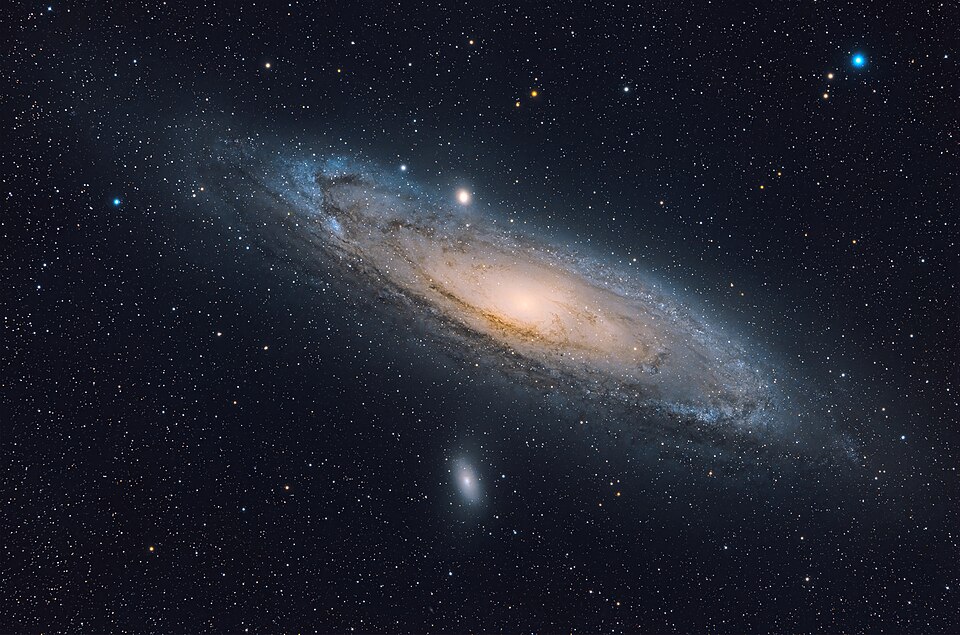
When will the Milky Way and Andromeda collide? The Milky Way Galaxy and the Andromeda Galaxy will collide in about 4.5 billion years. None of us, nor our sun, will be here to see it. We might still be in the Milky Way, but we certainly won’t be here on Earth.
The Milky Way Galaxy is a spiral armed galaxy that contains roughly between 100 and 400 billion stars. Each star probably has a number of planets, so there is a lot of matter. The galaxy is about 100,000 light-years across and several thousand light-years thick at its thickest point. Most of the stars are clustered into the central 80,000 light-years and then they thin out. Our solar system is about 27,000 light-years away from the center of the galaxy. If you look up at the night sky and there isn’t much light pollution, you can see to the center of the Milky Way. It looks bright because most of the stars are clustered in close to the center. There is a supermassive black hole at the center of the galaxy called Sagittarius A. The oldest stars in the universe are about the same age as the universe itself and must have formed just after the big bang.
The Andromeda Galaxy is also a spiral galaxy. It is larger than the Milky Way Galaxy and is thought to contain over a trillion stars. The Andromeda Galaxy is about 176,000 light years across and slightly thicker than the Milky Way. If it is a very clear night, you can see the Andromeda Galaxy with the naked eye. The Andromeda galaxy is thought to be so massive because it was probably formed when two smaller galaxies collided approximately three billion years ago. Astronomers believe this because there was a sudden spike in star formation around about this time that suddenly stopped. When two galaxies collide, it removes all of the interstellar gas and puts a hold on star formation. There are also streams of stars that move in a coordinated way, as though they were picked up on their way to somewhere else. Astronomers believe the galaxy that collided with Andromeda was the M32 galaxy, which looks like a spiral galaxy that has had most of its stars and matter torn off.
The Andromeda galaxy is currently 2.5 million light-years away from Earth. By looking at how much it is blue shifting, astronomers have estimated that it is travelling towards us at a speed of 110 km per second. When something is moving away from us, its light waves get longer and it appears more red, and when something is moving towards us its light waves get shorter and it appears more blue. 110 km per second is 6,600 km a minute, 396,000 km an hour, and 9,504,000 km a day. A light year is 9,461,000,000,000 km, so the Andromeda galaxy will come one light-year closer to us in 995,475 days, which is 2,727 years. The Andromeda galaxy is 2.5 million light-years away, so the center of it will collide with the Milky Way in 6,818,325,953 years, roughly. The edge of each galaxy should come into contact with each other in about 4 billion years or so. What will happen?
The two galaxies will probably make close passes before they collide with each other and when they do, the larger Andromeda galaxy will pull through the Milky Way, stretching it. The Milky Way is too large to be pulled apart, like M32, and the two galaxies will end up as a longer, elliptical galaxy. The supermassive blackholes at the center of each galaxy will circle each other, getting closer and closer until they merge. That will take about 17 million years. In our heads, we see the one galaxy smashing through the other and pulling it along, but this process will not be fast. It will probably take about five billion years from when the two galaxies meet to them being joined and settling down. And it is very unlikely that any of the stars inside either galaxy will collide. There may be a trillion and a half stars combined between the two galaxies, but the space between all of the stars is so enormous that they just won’t meet. Our closest star (after the sun) is 4.5 light years away. However, some stars may be flung out of their galaxy and go flying off into space as a lone star. Earth will have gone long before the two galaxies meet, so we won’t be able to watch it from here. And this is what I learned today.
Sources
https://www.skyatnightmagazine.com/space-science/andromeda-milky-way-galaxy-collision
https://news.berkeley.edu/2025/01/16/the-andromeda-galaxy-struts-its-stuff
https://en.wikipedia.org/wiki/Andromeda_Galaxy
https://en.wikipedia.org/wiki/Andromeda%E2%80%93Milky_Way_collision
https://en.wikipedia.org/wiki/Galactic_Center
https://en.wikipedia.org/wiki/Milky_Way
https://www.skyatnightmagazine.com/space-science/andromeda-milky-way-galaxy-collision
https://www.britannica.com/video/Fritz-Zwicky-inference-dark-matter-existence/-206958
Image By I, Luc Viatour, CC BY-SA 2.5, https://commons.wikimedia.org/w/index.php?curid=150485855

